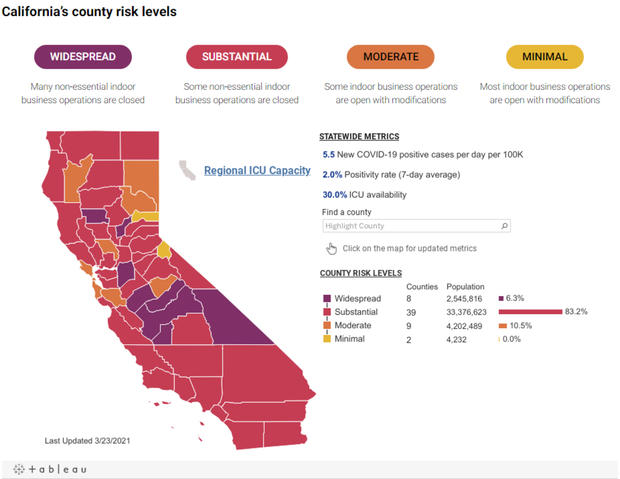COVID: San Francisco Moves Into Orange Tier; Restaurants Move To 50 Percent Indoor Capacity
SAN FRANCISCO (CBS SF) -- With new cases continuing to decline and the number of local residents vaccinated on the rise, San Francisco officials announced Tuesday the state has elevated the county to the Orange Tier, allowing non-essential businesses to reopen offices and restaurant indoor dining capacity to grow to 50 percent.
The city/county had last been in the Orange Tier last fall before the post-Thanksgiving surge in new cases forced into back into the most restrictive Purple Tier.
Santa Clara and Marin counties also moved to the Orange Tier on Tuesday.
Mayor London Breed said the move to the Orange Tier would also allow for the reopening of non-essential offices at 25 percent.
"I'm tired of working from home. I think when we reopen, more and more people are going to want to return to work and to be around other folks," said Breed.
While the return of workers to the city's battered downtown will doubtless help the businesses that have been languishing since last March, it may take years to understand the long-term repercussions.
"For us, that means 25% capacity -- about 14 employees maximum -- can be in our office tomorrow," explains Jason Alderman, Communications Chief for Fast, a San Francisco-based startup.
The Fast team will reboot their SOMA office space Wednesday. Alderman told KPIX not everyone is dying to come back, but many are.
"This is a very serious illness, but there are several members of our team who want to be back in the office," Alderman said. "There are many of us who feel we do our best work face to face."
The mayor called the city's arrival at the orange tier the start of the downtown rebound.
"What that means is downtown is going to start to come alive again," said Breed.
However, she allowed that the pandemic's effects here may be lasting in some ways.
"Downtown may change, and we know it may change," Breed explained. "We know that there are companies that are talking specifically about working from home."
"Definitely starting to pick up a little bit," SF resident Lorenzo Hawkins said of the streets and sidewalks downtown. "More cars, more traffic, and starting to be more foot traffic."
Hawkins said traffic has been picking up in recent weeks. But as for what happens longer term, he's unsure.
"That's a tough one," Hawkins said. "You have a lot of people that have been stuck in the house all year. They are restless and they want to get out and mix up the routine. Then you have some people that have been used to staying home. So it's a tossup. Some people are going to come back, some people aren't."
With this move, San Francisco will also be able to open bars and breweries for outdoor service. City officials said they will also work to establish a timeline to resume outdoor arts, theater and music performances and festivals for audiences of up to 50 people beginning April 1. In addition, the city is working to create guidelines for outdoor spectator sports and large outdoor entertainment venues.
"This year has been so tough on so many—from our kids and families, to our small businesses and their employees—and this move to the Orange Tier and reopening more activities and businesses than we have since last March gives us all more hope for the future," she said.
"We're expanding more activities and opportunities for San Franciscans to have fun and enjoy their city, and making it easier on our businesses to operate and recover."
But Breed did admit that some changes during the pandemic will remain including outdoor dining parklets.
"They're staying," she said. "Don't they make the city look good?"
San Francisco was also now expanding the number of people able to participate in outdoor gatherings to 25. Following guidelines from the U.S. Centers for Disease Control and Prevention, the city has also announced the resumption of indoor small gatherings in residences for up to 12 people of up to three households.
New COVID-19 cases and hospitalizations continue to decline. San Francisco is currently averaging 31 new cases a day, which is comparable to where the city was in mid-November before the most recent surge.
But among the new cases, there has also been a growing prevalence of the U.K. (B.1.1.7), West Coast (B.1.427 and B.1.428) and the South African (B.1.351) variants in the Bay Area as well as the Brazilian variant (P.1), which was recently detected in California.
At this time, nearly 40% of San Francisco's population has received the first dose of vaccine, as have 77% of the city's residents over 65.
"The light at the end of the tunnel is shining brighter every day; we just have to get more vaccine and buckle down a little longer until we reach the end," said city health director Dr. Grant Colfax.
Activities to Resume Wednesday, March 24, 2021
The following activities may be reopened:
Offices
- Indoor non-essential offices of 20 or more employees may reopen at up to 25% capacity, including meeting and conference rooms at 25% (though use of conference rooms should be minimized).
- Indoor offices of fewer than 20 employees must reduce their capacity to whatever allows for required 6 feet of physical distancing between employees at all times.
Indoor family entertainment
- Indoor bowling alleys, mini golf, pool halls, and other family entertainment where individuals may readily maintain at least 6 feet of distance may open up to 25% capacity with groups consisting of members of one household.
- Concessions are allowed following indoor dining rules in a separate room or with 12 feet of space from other activities.
Indoor recreation
- Indoor recreational facilities may open to 25% capacity up to 100 people.
- Up to 12 participants from up to 3 households may participate in low-contact indoor recreation (and from up to 4 households in the case of indoor tennis and pickleball).
- Indoor organized sports for youth and adults may resume with stable groups of up to 16 participants, with no household limitation. For moderate- or high-contact sport involving middle school, high school or adult participants, regular testing and a COVID-19 prevention plan must be in place. Elementary age children may not participate in moderate or high contact sports. Spectators are not allowed in any context except the necessary supervision of children in youth sports. Adults may only participate in up to two organized activities at a time, and only one activity if it is a moderate- or high-contact sport. Youth may only participate in one organized indoor activity at a time.
- Competitions may only occur in county or with teams from adjacent counties (i.e., Marin, San Mateo, and Alameda) in an equal or less restrictive tier. Consistent with State guidelines, travel for out of state tournaments may not take place.
- Indoor ice hockey, wrestling, and water polo remain prohibited.
Indoor gatherings
- Up to 12 people from 3 households may gather in a private residence, with face coverings and with ventilation measures and distancing urged. Such gatherings are discouraged unless they are gatherings with vaccinated individuals consistent with CDC guidelines. If possible gatherings should take place outdoors.
Outdoor bars, breweries, wineries and distilleries
- Bars, breweries, wineries and distilleries may open for outdoor, seated table service of up to 6 people at a table without the provision of a meal. Guests may not mingle between tables. Indoor bars, breweries and wineries without meal service remain closed.
Dining
- Indoor dining at restaurants, bars serving meals, cafes and coffee shops, hotels, museums, and food courts in shopping malls may expand to 50% capacity up to 200 patrons. Table size may expand to up to 6 guests from up to 3 households. Service must end by 11:00 pm.
- Outdoor dining may remove restrictions of number of households seated at a table and may allow group reservations of up to two tables outdoors (12 people maximum). Tables remain limited to 6 guests. Tables may be seated outdoors for drink service only.
Gyms and Fitness
- Indoor gyms, fitness centers and climbing walls may expand to 25% capacity up to 100 patrons, including youth patrons under the age of 18.
- Group fitness classes including cardio may resume up to lesser of 25% capacity or 100 people.
- Indoor locker rooms and showers may open with the implementation of a DPH approved ventilation measure. Indoor sauna, steam rooms and hot tubs remain closed.
- The 25-person limitation to outdoor fitness classes is lifted as long as physical distancing between participants can be maintained.
Retail
- Stand-alone retail, shopping centers, low-contact retail services, equipment rental, financial institutions, laundromats, etc. may expand indoor customer capacity to 50%.
- Personnel may handle customer-supplied items such as reusable bags, jars, mugs, and other containers.
Personal services
- Indoor personal services may expand to 50% customer capacity.
Museums, zoos, and aquariums
- Indoor museums, zoos and aquariums may expand to 50% customer capacity with an approved safety plan. Coat rooms and interactive exhibits may resume with sanitation protocols in place. Auditoriums may reopen for movies following indoor movie theater guidelines.
- Outdoor zoos may expand to full capacity outdoors, with physical distancing in place under an approved safety plan.
Indoor worship and funerals
- Indoor worship and funerals may expand to 50% capacity and may resume singing, chanting and playing wind and brass instruments following applicable health rules including face coverings and maintaining 12 feet of distancing between households.
Live Entertainment
- Indoor and outdoor live entertainment in a dining or other permitted venue context may include singing and playing wind and brass instruments following applicable health rules including face coverings and maintaining 12 feet of distancing between households.
- Outdoor live entertainment in a drive-in context may increase beyond 6 entertainers to whatever is possible with physical distancing in place and may include singing and playing wind and brass instruments following applicable health rules including face coverings and maintaining 12 feet of distancing between households.
Wilson Walker contributed to this story.




